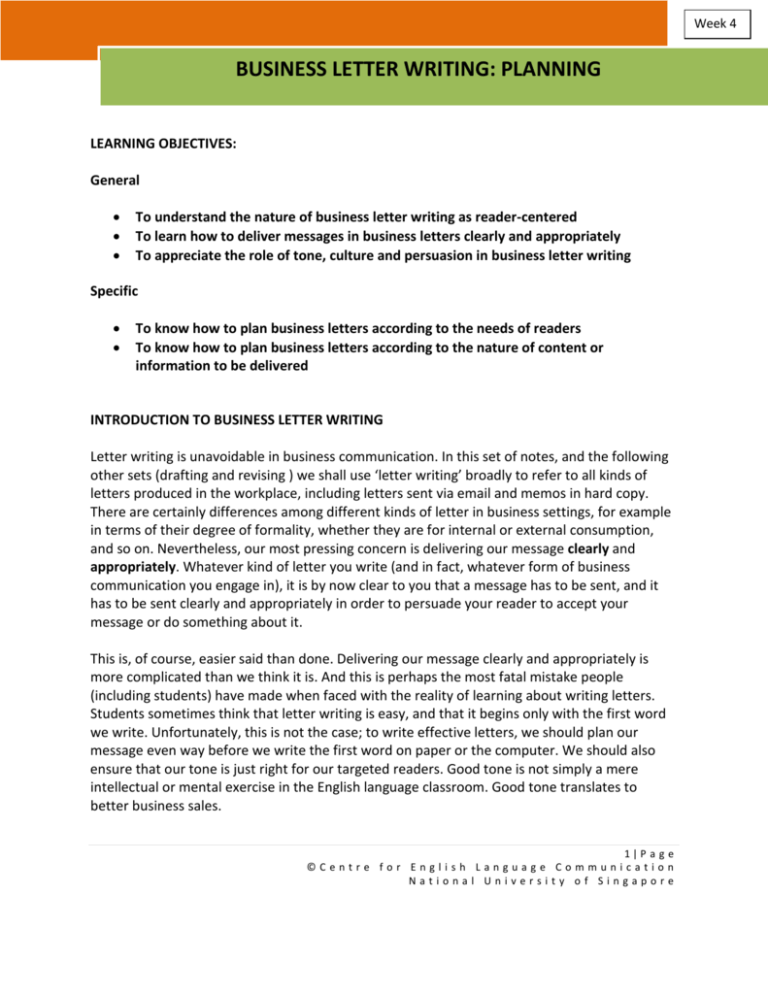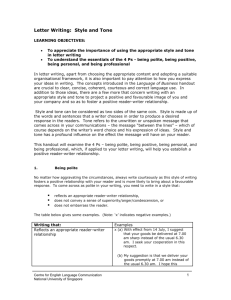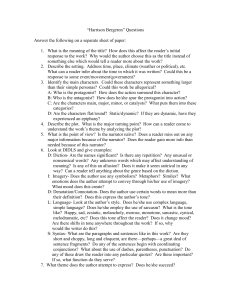business letter writing: planning - National University of Singapore
advertisement

Week 4 BUSINESS LETTER WRITING: PLANNING LEARNING OBJECTIVES: General • • • To understand the nature of business letter writing as reader-centered To learn how to deliver messages in business letters clearly and appropriately To appreciate the role of tone, culture and persuasion in business letter writing Specific • • To know how to plan business letters according to the needs of readers To know how to plan business letters according to the nature of content or information to be delivered INTRODUCTION TO BUSINESS LETTER WRITING Letter writing is unavoidable in business communication. In this set of notes, and the following other sets (drafting and revising ) we shall use ‘letter writing’ broadly to refer to all kinds of letters produced in the workplace, including letters sent via email and memos in hard copy. There are certainly differences among different kinds of letter in business settings, for example in terms of their degree of formality, whether they are for internal or external consumption, and so on. Nevertheless, our most pressing concern is delivering our message clearly and appropriately. Whatever kind of letter you write (and in fact, whatever form of business communication you engage in), it is by now clear to you that a message has to be sent, and it has to be sent clearly and appropriately in order to persuade your reader to accept your message or do something about it. This is, of course, easier said than done. Delivering our message clearly and appropriately is more complicated than we think it is. And this is perhaps the most fatal mistake people (including students) have made when faced with the reality of learning about writing letters. Students sometimes think that letter writing is easy, and that it begins only with the first word we write. Unfortunately, this is not the case; to write effective letters, we should plan our message even way before we write the first word on paper or the computer. We should also ensure that our tone is just right for our targeted readers. Good tone is not simply a mere intellectual or mental exercise in the English language classroom. Good tone translates to better business sales. 1|P a g e ©Centre for English Language Communication National University of Singapore B ASIC ELEMENTS OF AN EFFECTIVE BUSINESS LETTER An effective business letter must be able to accomplish two basic things: deliver your message (1) clearly and (2) appropriately. Deliver your message clearly To achieve clarity of message, you must accomplish these: 1. 2. 3. 4. The aim or purpose of the letter is clearly stated and strategically placed. The problems or issues to be addressed are correctly articulated. Ideas and information are organized into a structure based on audience needs. Information is correct and complete. Deliver your message appropriately To achieve appropriateness in the delivery of message, you must accomplish these: 5. Use simple language (3Cs). It must be: Clear (simple, concrete and specific words in complete sentences) Concise (most economical use of words to deliver message) Correct (free from basic grammatical errors) 6. Use appropriate tone and style (4Ps). They must be: Polite Positive Personal Professional 7. Format and/or package the letter properly. If your message is delivered clearly and appropriately, you will most likely have a persuasive letter. 2|P a g e ©Centre for English Language Communication National University of Singapore T HE PROCESS OF LETTER WRITING In order to accomplish the above requirements for an effective business letter, going through the process of writing it is necessary. There are four main steps in the process: PLANNING ORGANIZING DRAFTING REVISING PLANNING In planning your letter, you must undertake to do the following, with accompanying questions which can help you tease out the issues even more concretely: Planning Worksheet o Determine the message and purpose of the letter. What is the main purpose of your letter, or What do you want to do in the letter? (e.g., to sell our company’s newest product, to encourage volunteer work in a charity organization, to ask for a refund for Product A, to reject a request for deadline extension) ___________________________________________________________________________ What is the core message that you want to convey to the reader? (e.g., “I want a refund for Product A”, “Buy our newest product in the market”, “Please volunteer your time in a charity work for children”, “We reject your request for a deadline extension). ___________________________________________________________________________ What is/are the reason(s) for the main message? (e.g., “I want a refund for Product A because your customer service is bad”, “Buy our newest product in the market because it has unique features”, “Please volunteer your time in a charity work for children because it is a worthwhile activity”) __________________________________________________________________________________________ __________________________________________________________________________________________ Note that some business letters do not provide reasons for certain decisions made. For example, when credit card companies reject applications for new cards, they simply tell you it is unable to give you one without any reason. What is the nature of the letter based on your message? (e.g., persuasive, informative, descriptive) ___________________________________________________________________________ Note that business letters are essentially persuasive. However, there are cases when they are not. For example, when you are asked to provide details about a person’s transaction history, the letter is essentially informative. Some letters can also be descriptive, for example when you describe to a customer how a machine works. Nevertheless, business letters are still generally about persuading people. 3|P a g e ©Centre for English Language Communication National University of Singapore o Analyze your reader. How familiar is your reader with the subject you are writing about? ________________________________________________________________________ What specific pieces of information do you need to furnish your reader in order for her to understand your letter? ________________________________________________________________________ ________________________________________________________________________ ________________________________________________________________________ Which parts of your letter is the reader likely to accept, and which parts is she likely to reject? ________________________________________________________________________ ________________________________________________________________________ What are your reader’s characteristics with respect to her position in the organization, educational background, familiarity with the technicalities of your profession, and any other characteristics that you need to consider in writing this letter? ________________________________________________________________________ ________________________________________________________________________ What is your social and professional relationship with your reader? How may this influence her response to your letter? ________________________________________________________________________ ________________________________________________________________________ ________________________________________________________________________ What is your reader’s attitude towards you and the subject likely to be? What would you want it to be after she has read your letter? ________________________________________________________________________ ________________________________________________________________________ ________________________________________________________________________ 4|P a g e ©Centre for English Language Communication National University of Singapore TUTORIAL EXERCISES ACTIVITY 1: Determining the core message and understanding the audience Read the The Consultancy Project notes again and familiarize yourselves with the context of the project. Then, read the following notes on the letter writing assignment: The Sales Department of Golden Clothes Asia has asked you to draft a letter to one group of sales employees requiring them to attend a series of oral presentation workshops. The Sales Department got the top management to approve the plan to require a targeted group of employees (16 out of 36) in the department to make a mock oral presentation in front of you. Because of the company’s expanding market reach, the targeted group of sales employees is expected to make presentations to co-workers and customers on topics that are relevant to these people. The bosses at the department think that these employees lack even the basic skills in making oral presentations. In addition to the above essential information, you are also aware of differing values in the workplace due to inter-generational gaps. According to Chris Fenney, co-founder and director of Training Edge International, “Different generations have different approaches to the same problem. Different is neither right or wrong – just different. Remember, the generational context is not about age, but common experiences”. 1 What will the differences be in your letter writing approach and content if you are writing to specific groups of workers, e.g., The Matures, The Boomers, The Generation X, and The Generation Y? Do you agree with the views? What are potential uses and dangers of categorizing groups of people? Discuss these questions with your groupmates. INTER-GENERATIONAL CULTURES AT THE WORKPLACE 2 The Matures The Boomers Generation X Born between 1964 and 1980 Diversity Entrepreneurial It is a way to get ahead By investing it Generational context Defining idea Work style View of education Born before 1945 Duty Team player It is a dream Born between 1945 and 1964 Individuality Self-absorbed It is a birthright Money By saving it By spending it 1 (Fenny, 2010) 2 (Fenny, 2010) Generation Y Born after 1980 Back to basics Team player It is a lifelong endeavor By spending their 5|P a g e ©Centre for English Language Communication National University of Singapore management Values Work ethic Dedication, law and order and a strong work ethic; risk averse, have respect for authority and loyalty to the organization Stable, detailoriented, thorough, loyal and hard working; often uncomfortable with change and ambiguity, reluctant to buck the system, prefer to avoid conflict and reticent when they disagree parents’ dollars Optimism, confidence, ambition and achievement in education, idealism, fun and diversity Optimism, teamwork, personal gratification, promotion and recognition, health and wellness Diversity, a balance in life, computer literacy, personal development, informality and initiative Service-oriented driven, good at relationships, want to please and good team players; not naturally “budgetminded”, uncomfortable with conflict, reluctant to go against peers, put process ahead of results and overly sensitive to feedback “Feedback once a year” Adaptable, technoliterate, independent, not intimidated by authority, and creative; can be impatient, have poor people skills, inexperienced and cynical. Loyal, optimistic and tolerant, adept at multi-tasking; fast thinkers and technological savvy; in need of supervision and structure; inexperienced – particularly with handling different people issues – and low service levels. “Sorry to interrupt but how am I doing?” Leaders must give them many projects and lots of control, offer constructive and straightforward feedback, invest in computer technology, resist micro managing them, provide a flexible work environment and reward initiative “Feedback at the push of the button” Attitude to feedback “No news is good news” Leading them Leaders must make time for their hard work with symbolic records of achievement, verbally and publicly acknowledge their experience, provide proactive technology support and create ways they can mentor others Leaders must give them lots of public recognition, a chance to prove their worth, perks with status, ask for their inputs and get their consensus Training Give them the big picture, emphasize long-term goals, let them share their experiences Focus on the near future, challenges and their role, and provide development experiences Focus on balance, offer them access to many different kinds of information and provide electronic support Leaders must learn about their personal goals and find ways to mesh these with the company’s goals; forget traditional gender roles, be sensitive to the potential for conflict with Gen EXers, develop a hands-off style, open avenues for education and skill building and introduce mentoring programmes Let them know that what they do matters, communicate expectations, focus on boosting their customer service and interpersonal skills 6|P a g e ©Centre for English Language Communication National University of Singapore ACTIVITY 2: Planning the letter Letter Writing Planning Activity: Below are more details about your target audience. Use these details, together with the general notes above about the request from the Sales Department, as well as the intercultural information on inter-generational differences above, to help your EACT™ team shape your letter more effectively. Use the planning worksheet above (pp. 3-4) to guide your team in the discussion and planning of the letter. Be ready to share your plan with the rest of the class. The challenge here is to persuade your target readers to participate in the activity. They are all university graduates (with 5 – 8 years of experience in the workplace) who have proven records in successful sales. The problem of “face” in the company and in the culture that they are from makes this plan even more difficult to implement. Plus: the possibility of being fired after they are found to be lacking in many essential skills in oral presentation is also a valid concern. The letter will have to be written by you – the EACT™ team – but the Director of the Sales Department is the signatory. Bibliography Fenny, C. (2010, July 10). Closing the generational gap. The Straits Times , p. R34. 7|P a g e ©Centre for English Language Communication National University of Singapore








